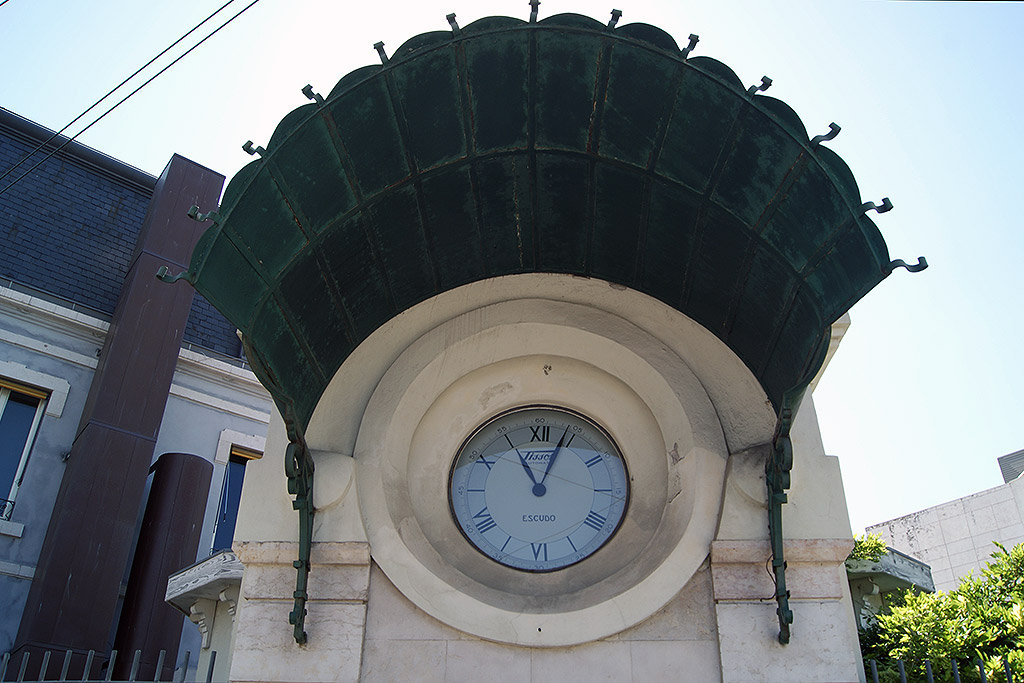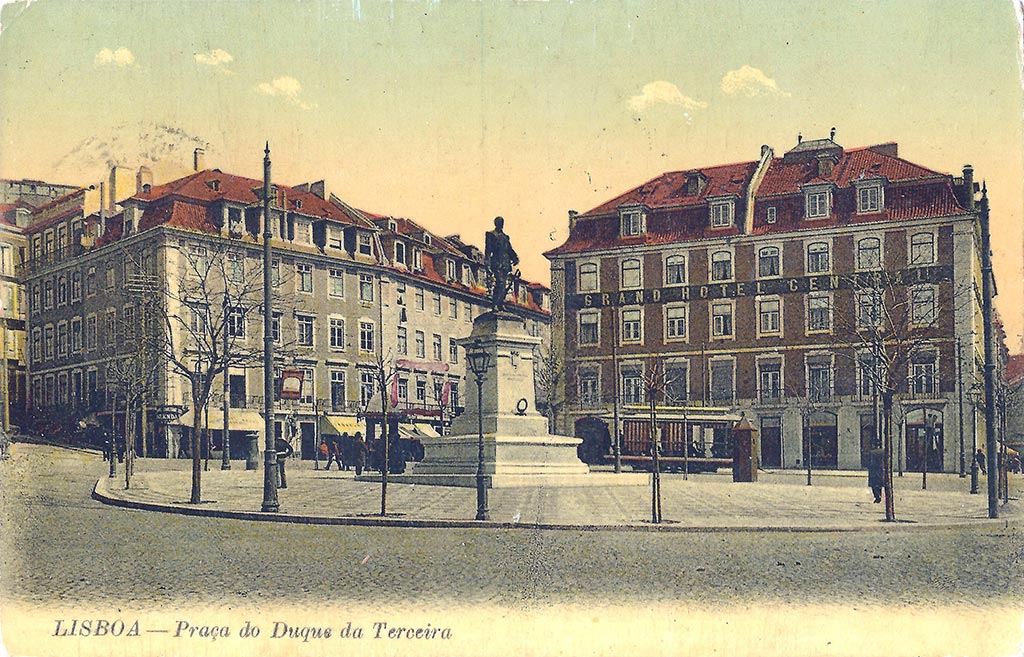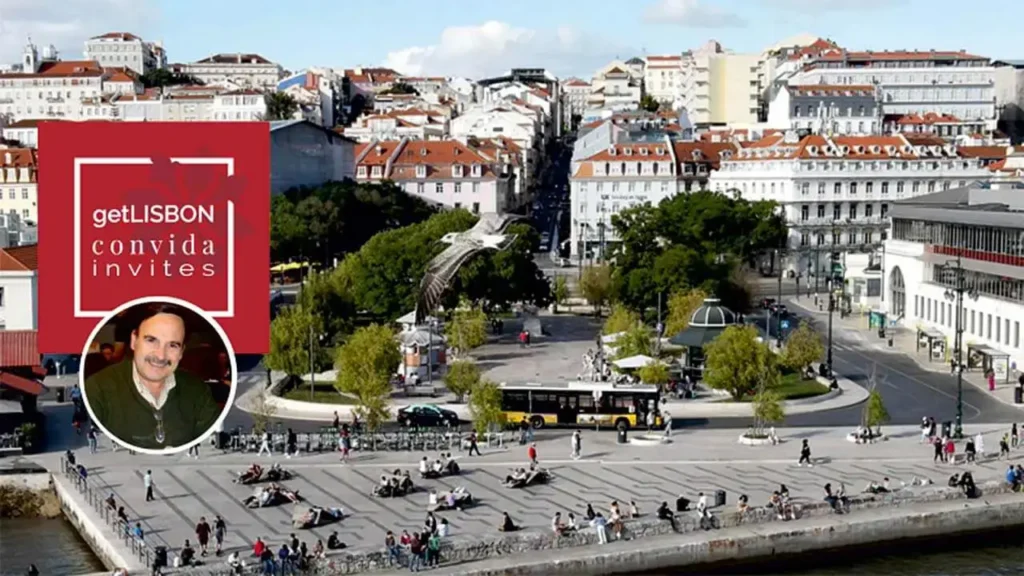Our new series getLISBON invite starts its first publication with one of the chronicles dedicated to Lisbon riverside, written by a friend and collaborator since day one.
In Lisbon in Us by Luís Bayó Veiga, this collector revealed to us his passion for this city. Now he shares with us his role as a researcher through a description of the area of Cais do Sodré, its origin and experiences, properly illustrated with postcards from his rich collection.
With this chronicle, we learn how the Duque da Terceira Square known as Cais do Sodré, together with its surroundings, has developed as a meeting point, passage and crossroad for different people, a place that unites the city and the Tagus river, a reference for nightlife and Lisbon’s bohemian lifestyle…

Surely, there’s no one (from Lisbon or not), who lives or works in the Capital or who has visited it, who hasn’t heard about the area of Cais do Sodré and its square.
Located by the river, the area of Cais do Sodré comprises a vast extension. It’s limited to the east, by the end that joins Corpo Santo Square, to where a few years ago the ferryboat station was located, and to the west by the end that goes from S. Paulo Square to the railway station, commonly known as Cais do Sodré station. To the north this area is limited by the streets of Corpo Santo, Bernardino Costa and S. Paulo and to the south by the Tagus river, in the section between the extinct river station and the place then named as Ribeira Nova.
However, strictly speaking, the toponym “Cais do Sodré” doesn’t in fact correspond to the space described above. It is, by public notice, the public riverside section that runs from Duque da Terceira Square (the real name of this vast surrounding area), and ends at the end of Corpo Santo Square.
Within the scope of this short chronicle, in line with oral tradition and common slang, we’ll use the name Cais do Sodré Square to describe it.
For those who don’t know, the name Cais do Sodré only appeared after the earthquake of 1755, when, under the command of the Marquis of Pombal, the city’s reconstruction work began, particularly in this riverside area.
But what is the Origin of the Name “Cais do Sodré”?
According to Júlio Castilho (1840-1919), a distinguished Lisbon studies specialist, the toponym “Sodré” was already known since the 15th century. It came from an English origin family residing there, in which António and Duarte Sodré Pereira Tibau, heirs of Frederico Sodré (1432-1481), were the owners of several properties located in that area and in its surroundings.
The writer and historian Silva Túlio (1818-1884) defended another origin of that name. He wrote that “Sodré” came from Vicente Sodré, descendant of Fradique Sodré (16th century), a man who had at the time a high financial power and owned several buildings in that area.
In any case, the designations of the area and of the Cais do Sodré Square have become rooted in the voice of the people and have resisted until this day.
The Area of Remolares
Before the earthquake, in this riverside and maritime location, the river waters penetrated inland, forming a sandy cove.
It was then known as the area of Remolares (paddle makers), perhaps because there were several artisans who dedicated themselves to making paddles for boats.
With the urbanisation foreseen in the Lisbon reconstruction plan, the city was divided into neighbourhoods, with this location being included in the Remolares neighbourhood.
Due to the landfills, more space was gained, forming a vast square, which was given the name of Remolares Square.
However, as this area was previously called Cais do Sodré, that square for a few more years had both names simultaneously. The toponym Remolares gradually fell into oblivion by the people however, it can be found in streets nearby, Travessa and Rua dos Remolares.
First Urban Improvements
In 1849, this square, after being duly levelled, was cobbled with black and white designs and trees were planted around it. A pedestal made by limestone was placed at the centre which access was made by a circular stair, and on which a horizontal quadrant was placed, named “Meridian of Remolares or Meridian of Cais do Sodré”, which was nothing more than a sundial that remained there until 1874.

In 1907, the headquarters of the General Administration of the Port of Lisbon (AGPL) was inaugurated, located in a building built on piles on the Tagus riverside, located on the corner between Cais do Sodré Square and the beginning of Rua da Ribeira das Naus. On the outskirts, in 1914, a guardhouse was built in masonry, where a mechanical clock for public service was installed.
In the following year, the clock started to be connected directly by electrical cable to the Astronomical Observatory of Lisbon, located in Tapada da Ajuda, starting to inform the “Legal Hour”, which was established by law nº 1469 of March 30, 1915.
It was in operation until 2001, although it ceased to serve as the “Standard of Legal Time” and was replaced by an analogue quartz clock with high accuracy of time reading for public information, which continues to function until the present day.

In 1877, in the centre of the square, the monument with the bronze statue of the Duke of Terceira, by José Simões de Almeida (uncle), was inaugurated, in honour of one of the heroes of the Liberal Wars that took place between 1828 and 1834.
On the land conquered from the river after the landfill works, and in front of that monument, a garden called Cais do Sodré was built and where, in 1915, a statue, named “Ao Leme” (at the helm), by the sculptor Francisco Santos was placed.

With the end of World War I, this garden was renamed to Jardim dos Aliados (Garden of the Allies).
In 1934, it changed its name again to Roque Gameiro Garden, in honour of the great watercolourist who dedicated a large part of his work to painting scenes and places of Lisbon and who passed away in 1935.
The Growing Dynamism in the Area of Cais do Sodré

Next to the so-called Ribeira Nova and the market at “Praça da Ribeira” (1892), and halfway from Chiado through Rua do Alecrim (opened after 1755) and from Downtown Lisbon through Rua do Arsenal and Município Square, the Cais do Sodré Square gained increasing dynamism and local importance, especially from the last quarter of the 19th century. It was due to its great maritime movement of arrivals and departures that occurred at the berths nearby, that both in Cais do Sodré Square and in the surrounding streets, several shipping agencies and maritime facilities establishments started to appear.
In the early 1800s, the daily hustle of the ovarinas (fishwives) who supplied or traded fish in Ribeira Nova, and of the mingling of people passing through or workers in fishing activities or in riverside warehouses and also of the foreign seaman from the ships and sailboats that docked there was already intense.
Thus, like mushrooms, taverns, billiards, eateries and brothels were born, places of social gatherings, entertainment but also of stupidity and addiction, to which was added an effervescent nightlife distributed by bars and brothels, where addiction, cheating, prostitution and often crime proliferated…
We suggest you read the article The Art and Design of the WC Kiosks of Lisbon. It’s about the curious urban structure in Roque Gameiro Garden.
Cafes, Hotels and Gatherings

References to some establishments that ended up being part of the local history of Lisbon were forever registered in newspapers of the time and in memoirs, referring to, among the oldest, the “Botequim dos Macacos” (1780), the “Café do Greek” (1809), the “Café da Marinha” (1816) among others. Above all because they were the subject of experiences, occurrences, and memories of some characters who lived in Lisbon at that time.
Throughout the the 19th century, several dozen hotels and guest houses emerged, which among all stood out: the Wellington Hotel (1816), Hospedaria Estrela Branca (1835), Hotel de France (1838), Hospedaria Madame Júlia (1842), Hotel Braganza (1870), Hotel Giovetti (1871), Hotel Atlântico (1880), Hotel Veneza (1882), Grande Hotel Central (1890) and already in 1900, the Hotel Viana, which would have been one of the last to be installed in the local area.
Of all of them, the most famous was undoubtedly the “Grande Hotel Central”, which was located in the middle of Cais do Sodré Square, occupying a huge building in no. 27.

This hotel hosted kings, princes and relevant personalities linked to business, social and mundane life at the time.
Its “restaurant” was the stage for many meetings of businessmen and literary and arts gatherings.
Regularly gathered there in the late 1800s, Eça de Queirós, Ramalho Ortigão, Oliveira Martins, Conde de Ficalho, Lima Mayer, who, among others, were part of the famous “Os Vencidos da Vida” intellectual group.
But it was in chronicle and in Lisbon novel that the Grande Hotel Central became famous, its name being engraved in gold pages in some of Eça de Queirós’ novels, like “Cousin Bazilio” and “The Maias”.
The hotel closed its doors in 1919, (when many of the other hotels had disappeared) and today in that building, there are offices and a travel agency.
Among the many cafes that existed throughout the area of Cais do Sodré, we highlight the Café Royal, inaugurated in 1906 and located in the Cais do Sodré Square, right on the right corner where the ascent of Rua do Alecrim begins. This was the place where the painter Columbano (1857-1929) used to go for lunch in the last years of his life with his wife.
| Never miss another article | Subscribe here |
Cais do Sodré, Place of Arrivals and Departures
Over the years, Cais do Sodré and its surroundings were the stage for multiple events, inaugurations and improvements.
Some of these moments have already been referenced in this chronicle, but others, due to their importance at the time, are worth mentioning here.

In 1896, the railway line between Cais do Sodré and Pedrouços was inaugurated, but it was only in 1926 that the Cais do Sodré station building, as we know it today, was built, with the design of the architect Pardal Monteiro.

In 1899, the “Chalet da Parceria” was installed, located halfway along the Ribeira das Naus, place of arrivals and departures for the steamboats between Lisbon and Cacilhas (in the south bank).
A few years later, in 1904, the “Chalet” was replaced by the “Estação da Parceria dos Vapores Lisbonenses” (a steamboat station), this one already located almost in front of Roque Gameiro Garden.

Place of intense hustle and bustle, an important axis of the most diverse means of transport, maintaining its coastal maritime reference of its piers, and still a pole of attraction at night for its bars, bohemian and entertainment, maintaining its centuries-old design and its peculiar attractiveness, the area of Cais do Sodré will continue to be known and referenced as such, since 250 years ago it was first given the name that defines this unavoidable space in the history and life of Lisbon…
Also read
– A Brief History of Tagus Estuary Boats
– The Elegant Chiado of the Glove Shops
by this author.
References:
ARAÚJO, Norberto, Peregrinações em Lisboa, Livro XIII, Editora Vega, Lisboa 1993.
CARVALHO, Pinto (TINOP), Lisboa de Outros Tempos – Os Cafés, Fenda, Edições Lda, Lisboa 1991.
CONSIGLIERI, Carlos e ABEL, Marília, O Cais do Sodré em Bilhete Postal antigo, Livros Horizonte, Lisboa 2004.
FRANÇA, José-Augusto, Lisboa – História Física e Moral, Livros Horizonte, Lisboa 2008.
SANTANA, Francisco e SUCENA, Eduardo, Dicionário da História de Lisboa, Ed. Carlos Quintas & Assoc., Lisboa 1994.
TAVARES, Marina, Lisboa Desaparecida, vol.III, Quimera, Lisboa 2001.
VEIGA, Luis Filipe Bayó – Arquivo pessoal.

Luís Bayó Veiga
Curious and Lisbon lover, where he was born in 1948. Lives in Almada.
Collector of old Portuguese Comics and Illustrated Postcards about Lisbon, with thousands of items in his collections. He also has a significant collection of books, newspapers, magazines and supplements relating to the city.
Author of some books on memories and local history of Cacilhas and Almada. Co-author of more than a dozen documentaries on aspects of old Lisbon in multimedia support.
Member of the Grupo dos Amigos de Lisboa.
Assiduous attendee of conferences, colloquiums and others, organised by several public and private entities, in the scope of Lisbon studies.
Has a degree in Chemical Engineering from IST and two post-graduates from ISCTE.




